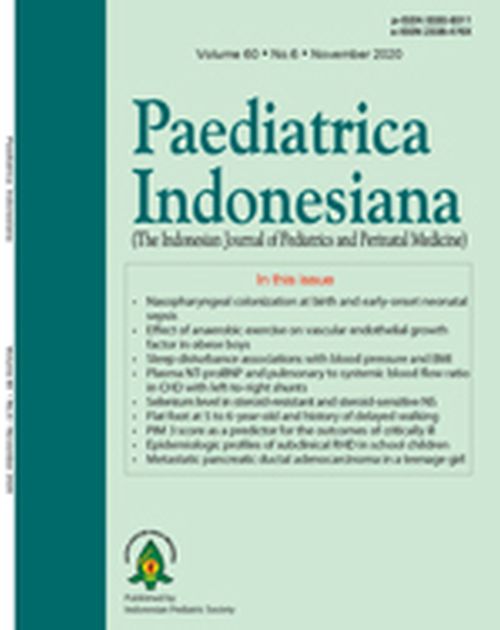Sleep disturbance associations with blood pressure and body mass index in school-aged children
DOI:
https://doi.org/10.14238/pi60.6.2020.303-9Keywords:
sleep disturbances; hypertension; obesityAbstract
Background Sleep disturbances can lead to many health problems in school-aged children, including hypertension and obesity. However, a lack of consensus about the etiology of these conditions is due to conflicting reports on the possible effects of sleep disturbances.
Objective To assess for possible associations between sleep disturbances and blood pressure as well as body mass index in school-aged children.
Methods This cross-sectional study involved primary school children in the 4th-5th grades. Subjects’ blood pressure, body weight, and body height were measured and their parents completed the Sleep Disturbances Scale for Children (SDSC) questionnaire.
Results Of the 816 children enrolled, 503 (61.6%) children had sleep disturbances. The most common type of sleep disturbance was initiating and maintaining sleep. Bivariate analysis revealed a significantly increased risk of hypertension among subjects with sleep disturbances (PR 15.06; 95%CI 8.13 to 27.90) and increased risk of obesity (PR 22.65; 95%CI 12.28 to 41.78).
Conclusion The most common type of sleep disturbance is initiating and maintaining sleep. Sleep disturbances are significantly associated with hypertension and obesity in children.
References
2. Javaheri S, Storfer-Isser A, Rosen C, Mitsnefes MM, Exami- N, Preece M, et al. Sleeping hours: What is the ideal number and how does age impact this? Pediatrics. 2007;10:421–30. doi: 10.2147/NSS.S163071.
3. Sekartini R, Adi NP. Gangguan Tidur pada Anak Usia Bawah Tiga Tahun di Lima Kota di Indonesia. Sari Pediatr. 2016;7:188. doi : 10.14238/sp7.4.2006.188-93.
4. Bhargava S. Diagnosis and Management of Common Sleep Problems in Children.Pediatrics in Review. 2011;32 (3) 91-99. doi : 10.1542/pir.32-3-91.
5. Putri H. Studi Deskriptif Gangguan Tidur Pada Anak Usia 9-12 Tahun di SD Negeri Pisangan 1 Ciputat Tahun 2015. 2015; Jakarta : Universitas Islam Negeri Syarif Hidayatullah. doi : IOS3659.79381.
6. Medic G, Wille M, Hemels MEH. Short- and long-term health consequences of sleep disruption. Nat Sci Sleep. 2017;9:151–61. doi : 10.2147/NSS.S134864.
7. Ambarita K, Ramayani OR, Lubis M, Ilmiati I, Ramayati R. Rasiotekanan darah terhadap tinggi badan dalam diagnosis hipertensi pada remaja. 2012;103–6.
8. Javaheri S, Storfer-isser A, Rosen CL, Redline S. Sleep Quality and Elevated Blood Pressure in Adolescents. 2008;1034–40. doi: 10.1161/CIRCULATIONAHA.108.766410.
9. Weaver DJ. Hypertension in Children and Adolescents. Pediatrics in Review. 2017: 38 (8) 369-382. doi : 10.1542/pir.2016-0106.
10. Marfuah D, Hadi H. Durasi dan Kualitas Tidur Hubungannya Dengan Obesitas Pada Anak Sekolah Dasar Di Kota Yogyakarta dan Kabupaten Bantul. Gizi dan Diet Indones. 2013;1:93–101. doi : 10.21927/ijnd.2013.1(2).93-101.
11. Cappuccio FP, Taggart FM, Kandala N-B, Currie A, Peile E, Stranges S, et al. Meta-analysis of short sleep duration and obesity in children and adults. Sleep. 2008;31:619–26. doi : 10.1093/sleep/31.5.619.
12. Weiss R, Bremer AA, Lustig RH. What is metabolic syndrome, and why are children getting it? Ann N Y Acad Sci. 2013;1281:123–40. doi : 10.1111/nyas.12030.
13. Bruni O, Ottaviano S, Guidetti V, Romoli M, Innocenzi M, Cortesi F, et al. The Sleep Disturbance Scale for Children (SDSC). Construction and validation of an instrument to evaluate sleep disturbances in childhood and adolescence. J Sleep Res. 1996;5:251–61. doi : 10.1111/j.1365-2869.1996.00251.x.
14. Natalia C, Sekartini R, Poesponegoro H. Skala Gangguan Tidur untuk Anak (SDSC) sebagai Instrumen Skrining Gangguan Tidur pada Anak Sekolah Lanjutan Tingkat Pertama. Sari Pediatr. 2011;12:365–72. doi : 10.14238/sp12.6.2011.365-72.
15. Huang MM, Qian Z, Wang J, Vaughn MG, Lee YL, Dong GH. Validation of the Sleep Disturbance Scale for Children and prevalence of parent-reported sleep disorder symptoms in Chinese children. Sleep Med. 2014;15:923–8. doi : 10.1016/j.sleep.2014.03.023.
16. Sekarwana N, Rachmadi D, Hilmanto D. Konsensus Tatalaksana Hipertensi pada Anak. Ikat Dr Anak Indones. 2011;3–11.
17. Kuczmarski RJ, Ogden CL, Guo SS et al. 2000 CDC Growth Charts for the United States: methods and development. Vital Heal Stat 11. 2002;246:1–190. PMID: 12043359
18. Ruan H, Xun P, Cai W, He K, Tang Q. Habitual Sleep Duration and Risk of Childhood Obesity: Systematic Review and Dose-response Meta-analysis of Prospective Cohort Studies. Sci Rep. 2015;5:1–14. doi: 10.1038/srep16160.
19. Horne J. Obesity and short sleep: Unlikely bedfellows? Obes Rev. 2011;12:84–94. doi : 10.1111/j.1467-789X.2010.00847.x.
20. Iglowstein I, Jenni OG, Molinari L, Largo RH. Sleep Duration From Infancy to Adolescence: Reference Values and Generational Trends. Pediatrics. 2003;111:302–7. doi : 10.1542/peds.111.2.302.
21. Paruthi S, Brooks LJ, D’Ambrosio C, Hall WA, Kotagal S, Lloyd RM, et al. Recommended Amount of Sleep for Pediatric Populations: A Consensus Statement of the American Academy of Sleep Medicine. J Clin Sleep Med. 2016;12:785–6. doi : 10.1542/peds.2016-1601.
22. Fuller C, Lehman E, Hicks S, Novick MB. Bedtime Use of Technology and Associated Sleep Problems in Children. Glob Pediatr Heal. 2017;4:2333794X1773697. doi : 10.1177/2333794X17736972.
23. Liu W, Lin R, Liu A, Du L, Chen Q. Prevalence and association between obesity and metabolic syndrome among Chinese elementary school children: A school-based survey. BMC Public Health. 2010;10:780. doi : 10.1186/1471-2458-10-780.
Downloads
Published
How to Cite
Issue
Section
License
Authors who publish with this journal agree to the following terms:
Authors retain copyright and grant the journal right of first publication with the work simultaneously licensed under a Creative Commons Attribution License that allows others to share the work with an acknowledgement of the work's authorship and initial publication in this journal.
Authors are able to enter into separate, additional contractual arrangements for the non-exclusive distribution of the journal's published version of the work (e.g., post it to an institutional repository or publish it in a book), with an acknowledgement of its initial publication in this journal.
Accepted 2020-10-16
Published 2020-10-16


















